Morning Sumo Practice Viewing in Tokyo
Morning sumo practice viewing tours in Tokyo offer a unique opportunity to glimpse into the daily lives of sumo wrestlers and the intricate rituals that govern this ancient sport. Visitors can choose from private guided tours or group walking tours that cater to diverse preferences and budgets, starting from around ¥7,100. These immersive experiences provide behind-the-scenes access to sumo stables, allowing visitors to appreciate the physical and mental demands of the sport. By attending a morning sumo practice, travelers can gain insight into this unique cultural phenomenon and explore the rich history and traditions surrounding it – and there’s still more to discover.
Just The Basics
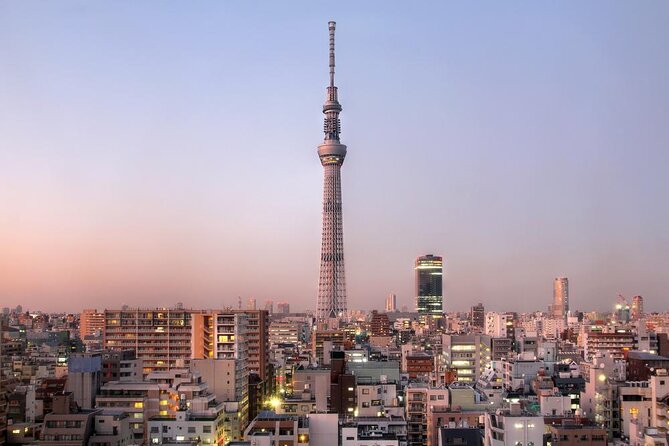
• Morning sumo practice viewing tours in Tokyo offer private guided experiences and culture starting from ¥7,100.
• Tours provide behind-the-scenes access to sumo stables, allowing visitors to observe wrestlers’ daily regimens and rituals.
• Expert guides share insightful commentary, providing a rundown of sumo history, ranking structure, and cultural significance.
• The tour includes a photo shooting session and information package, offering a unique and immersive experience.
• The meeting point is conveniently located at Tokyo Skytree Station, with hotel pick-up and drop-off services available for added convenience.
It's also worth checking out some other tours and experiences nearby.
Booking and Tour Options
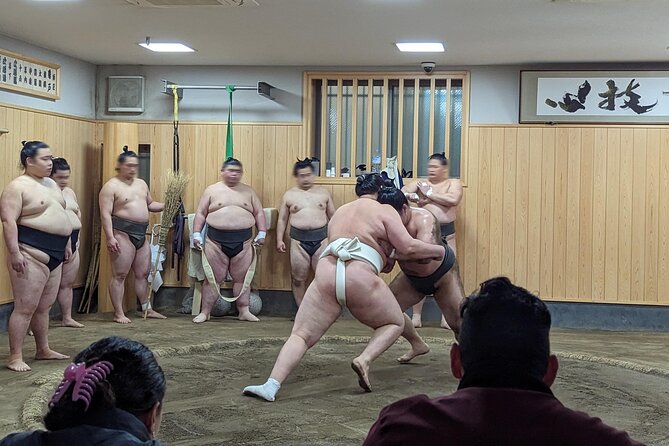
When booking a morning sumo practice viewing tour in Tokyo, travelers can choose from various options, including private guided tours and cultural exploration experiences.
These tours cater to diverse preferences and budgets, offering a range of activities and inclusions.
For instance, some tours focus on culture, while others prioritize behind-the-scenes access to sumo stables.
Travelers can opt for private tours with government-licensed guides or join group walking tours that cover iconic Tokyo landmarks.
With options starting from around ¥71, there’s something for all.
Exploring Sumo Culture
Delving into the world of sumo, visitors can uncover the rich cultural heritage and traditions surrounding this ancient Japanese sport.
Sumo culture is deeply rooted in Shintoism and Zen Buddhism, with rituals and customs that date back centuries.
The sport is built around the concept of ‘wa’ (harmony), which emphasizes respect, discipline, and self-control.
Sumo wrestlers, or rikishi, adhere to a strict code of conduct, following a rigorous training regimen that combines physical and mental discipline.
Visitors can gain insight into this unique cultural phenomenon by attending a morning sumo practice, where they can observe the wrestlers’ intense training and witness the intricate rituals that govern this ancient sport.
Behind the Scenes Experience

As visitors witness the rigorous morning training, they can gain a deeper understanding of the sumo wrestlers’ daily regimen and the intricate rituals that govern this ancient sport.
This behind-the-scenes experience offers a unique glimpse into the lives of these athletes, showcasing their dedication, discipline, and respect for tradition.
By observing the wrestlers’ pre-dawn stretching, exercise routines, and matches, visitors can appreciate the physical and mental demands of this ancient sport.
The intimate setting of the sumo stable provides an immersive experience, allowing visitors to connect with the wrestlers and gain insight into their daily routines.
This exceptional opportunity humanizes the sport, revealing the personalities, quirks, and passions of these modern-day samurai.
What to Expect on Tour
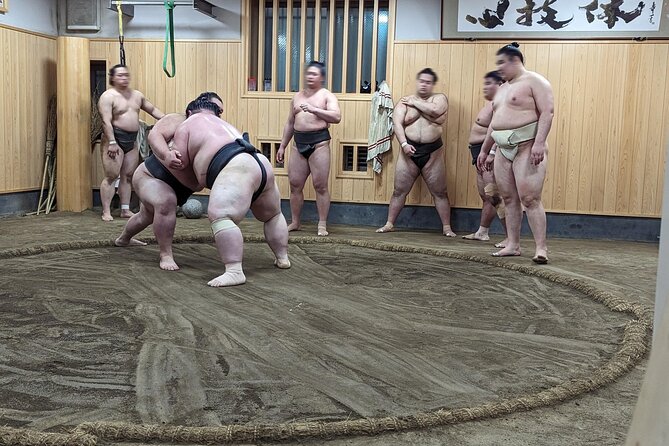
During this unique morning sumo practice viewing experience, visitors can expect an immersive and informative guided tour that delves into the world of sumo wrestling.
Throughout the tour, guests will gain a deeper understanding of sumo history and the ranking structure, providing a richer appreciation for the ancient sport.
The expert guide will share insightful commentary, providing a rundown of the sumo world.
Visitors can expect a behind-the-scenes look at the Naruto-beya Sumo Stable, offering a unique perspective on the daily lives of sumo wrestlers.
With a photo shooting session and information package included, visitors will leave with a newfound appreciation for this traditional Japanese sport.
Tour Logistics and Details
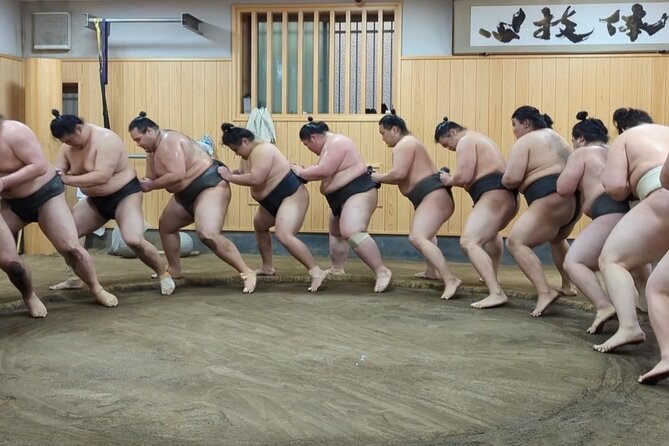
With the morning sumo practice viewing experience providing a unique glimpse into the world of sumo wrestling, attention turns to the logistical details that will ensure a seamless and enjoyable tour.
The tour logistics are carefully planned to provide a hassle-free experience.
The meeting point is conveniently located at Tokyo Skytree Station, with a meeting time of 07:30 am. Hotel pick-up and drop-off services are also available for added convenience.
The tour concludes at the Naruto-beya Sumo Stable, with easy access to public transportation.
It’s essential to note that the tour isn’t wheelchair accessible, and travelers with back problems may want to consider alternative options.
With these details in place, visitors can focus on seeing the fascinating world of sumo.
Sumo History and Ranking
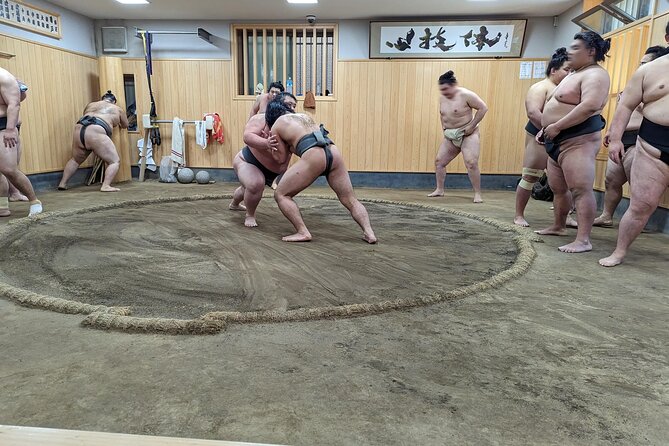
Sumo’s rich history, spanning over 1,500 years, has been shaped by a complex ranking system that determines a wrestler’s status and prestige within the sport.
The ranking system consists of six divisions, with the top division being Makuuchi. Within each division, wrestlers are ranked in a hierarchical order, with the highest rank being Yokozuna.
The ranking system is crucial, as it affects a wrestler’s income, training opportunities, and overall reputation.
A wrestler’s ranking can change depending on their performance in tournaments, with the ultimate goal being to reach the top rank of Yokozuna.
Understanding the ranking system is essential to appreciating the nuances of sumo culture and the dedication required to excel in this ancient sport.
Unique Photo Opportunities
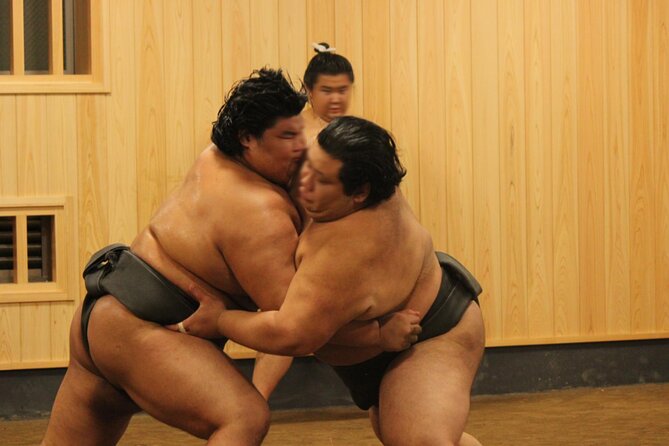
As you step into the Naruto-beya Sumo Stable, cameras at the ready, you’ll discover a treasure trove of unique photo opportunities, allowing you to capture the intense focus and discipline of these modern-day warriors.
| Photo Opportunities | Tips |
| Sumo wrestlers in action | Focus on dynamic poses and movements |
| Up-close portraits | Capture facial expressions and emotions |
| Training equipment and tools | Show the details and textures |
| Sumo wrestlers’ interactions | Highlight camaraderie and teamwork |
| Stable’s interior and architecture | Emphasize traditional Japanese design |
Take advantage of these unique photo opportunities to create a stunning visual narrative that tells the story of Japan’s ancient sport.
Getting to the Stable
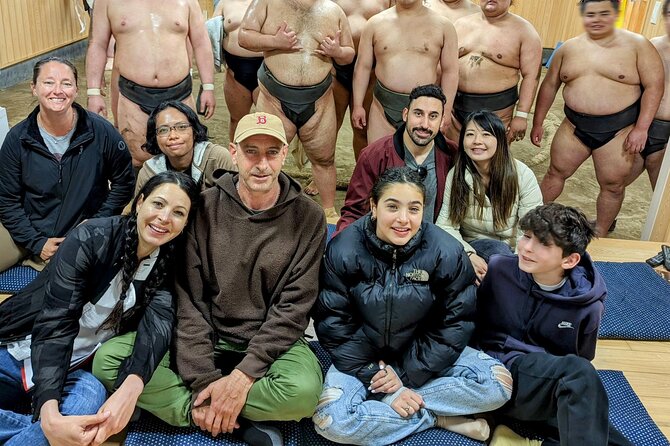
After capturing the perfect shot, it’s time to focus on the logistics of getting to the Naruto-beya Sumo Stable, a crucial step in experiencing the morning sumo practice viewing.
To get to the stable, meet at Tokyo Skytree Station at 07:30 am, where a certified guide will be waiting. From there, take a short journey to the Naruto-beya Sumo Stable, located in Sumida City, Tokyo.
Hotel pick-up and drop-off services are available, making it easy to get to the stable. The meeting point is conveniently located near public transportation, and the guide will provide clear directions to ensure a smooth arrival.
With the logistics taken care of, visitors can focus on what really matters – experiencing the unique and fascinating world of sumo.
Here's a few more nearby tours and experiences we think you'll like.
- 3 Hours Photography and Food Tour in Setagaya
- 1 Day Bus Tour To Mitsumine Shrine From Shinjuku
- Bunraku Performance In Kita-Senju Tokyo
- Tokyo Tour With Guided Interpreter Tokyo/Yokohama ⇒ Tokyo 8 Hours up to 18 People Private Bus Use
- Tokyo Narita Airport (NRT) to Hakone – Private Arrival Transfer
- 4-Days Private MT Fuji Tokyo Kamakura Nikko Hakone Yokohama Tour
Frequently Asked Questions
Can I Participate in Sumo Practice or Just Observe?
She observes, not participates, in the sumo practice, allowing her to respectfully witness the intense training while maintaining a safe distance, ensuring an immersive yet non-intrusive experience.
Are There Any Health Restrictions for Sumo Practice Viewing?
She notes that travelers with back problems are not recommended to participate, and infants must sit on laps, implying that certain physical limitations may hinder the sumo practice viewing experience.
Can I Bring a Stroller or Baby Carrier for My Infant?
She can’t bring a stroller, as the tour isn’t wheelchair accessible, but a baby carrier might be okay, although infants must sit on laps, so it’s best to check with the guide beforehand to confirm.
Are There Restrooms Available at the Sumo Stable?
She confirms that restrooms are typically available at the sumo stable, but it’s best to ask the guide for directions, as facilities might be limited or require a short walk, ensuring a comfortable experience.
Can I Purchase Sumo-Related Merchandise at the Stable?
She can’t purchase sumo-related merchandise at the stable, but her guide might know nearby shops or online stores selling authentic sumo gear, allowing her to still snag a souvenir.
Not for you? Here's more of our most recent tour reviews happening neaby
- Shibuya Anime and Manga Tour With Ramen Lunch
- Shibuya Hidden Street Eats: Japanese BBQ, Fried Chicken, & More!
- Kitchenware Shopping and Cooking Experience in Kappabashi
- Private Shopping Tour From Tokyo to Mitsui Outlet Park Makuhari
- Samurai Experience (with Costume Wearing)
- Tokyo: Samurai Experience and Show
- Tsukiji Old and New – Fish Market Food & Hamarikyu or Skyview
- Private Shopping Tour From Tokyo City to Lake Town Outlet
- A Typical Evening in Shinjuku
- Tokyo Kimono Experience @Japanese-Style Studio Near by Happo-En
- Izakaya Private Hopping Tour in Kamata
- Explore Nikko Toshogu Shrine and Edo Wonderland
- Private Trekking Experience up to 7th Station in Mt. Fuji
- Private Transfer: Tokyo to Haneda Airport HND in Luxury Car
- Morning Discount! Shuttle Van Transfer, Tokyo⇒Haneda, Narita, TDL
Final Words
As the morning sun dips below the horizon, the sumo practice session comes to a close, leaving participants with a profound appreciation for this revered martial art.
With a deeper understanding of sumo’s history, ranking structure, and cultural significance, visitors depart with unforgettable memories of their behind-the-scenes experience.
As they make their way back into Tokyo’s bustling streets, they carry with them a newfound respect for the strength, agility, and technique of sumo’s finest athletes.
